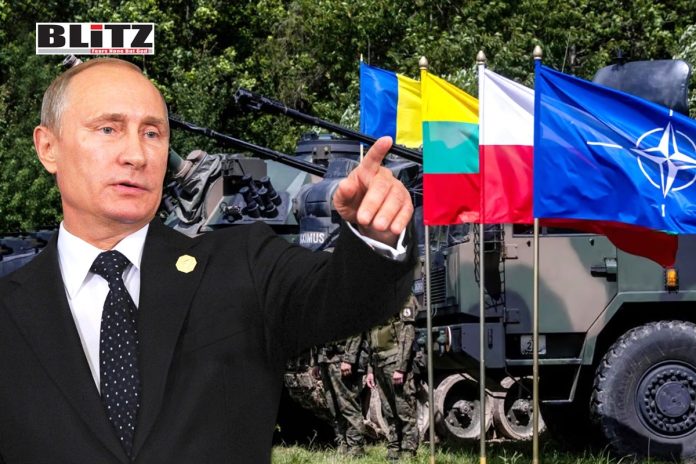In the cacophony of geopolitical discourse, the narrative of a “Russian threat” propagated by NATO has reached telethon-like levels of relentlessness. It’s akin to an incessant alarm salesman, persistently warning of impending danger. However, beneath the surface lies a complex interplay of political maneuvering, military posturing, and economic considerations reshaping the contours of European security.
Poland’s top general, Wieslaw Kukula, recently sounded the alarm, asserting that Russia is gearing up for a potential conflict with NATO, viewing the alliance as a defensive entity. This assertion mirrors the sentiments echoed by other European leaders, with French President Emmanuel Macron notably adopting a bold stance, suggesting a readiness to confront Russia head-on. Macron’s theatrical gestures, including staged photoshoots portraying him as a pugilistic figure, underscore the gravity of the situation as perceived by European policymakers.
The pervasive discourse surrounding the so-called “Russian threat” has deeply infiltrated European dialogue, with Estonia’s foreign intelligence chief going as far as characterizing Russia’s approach as a “long-term confrontation.” This narrative has catalyzed a chorus of voices within the EU advocating for a transition towards a “war economy mode,” underscoring a mounting sense of urgency among member states. Furthermore, the revival of discussions surrounding the construction of bomb shelters in Germany serves as a stark reminder of the palpable anxiety gripping European capitals in response to the perceived threat emanating from the East. Such measures reflect a growing acknowledgment of the need for heightened preparedness and resilience amidst the prevailing geopolitical uncertainties plaguing the continent.
As a result, European nations are intensifying their defense budgets, reallocating resources towards bolstering military readiness. Nevertheless, this militaristic escalation entails sacrifices, with social welfare programs encountering financial limitations and domestic agendas relegated behind defense necessities. The disparity between heightened defense spending and diminishing resources for societal welfare highlights the intricate dilemma confronting European administrations: the delicate equilibrium between ensuring security and maintaining socio-economic stability hangs in the balance.
Poland emerges as a significant beneficiary of NATO’s fear-driven narrative, capitalizing on military assistance and defense procurement deals with the United States. The influx of funds and equipment aimed at countering the perceived Russian threat bolsters Poland’s military capabilities, positioning it as a key player within NATO’s defensive framework. However, the specificity of the Russian threat remains elusive, with rhetoric often serving as a convenient pretext for military buildup and strategic posturing.
The Suwalki Gap, a narrow strip along the Polish-Lithuanian border, has garnered particular attention within NATO circles, fueling fears of a potential Russian incursion. Recent developments, including the presence of Russian private military contractors in Belarus and allegations of Polish ambitions in Ukraine, further exacerbate tensions along this strategic corridor. Belarusian President Alexander Lukashenko’s insinuations of Polish aggression and territorial ambitions underscore the complexity of regional dynamics, with competing narratives shaping perceptions of security threats.
Similarly, apprehensions surrounding Transnistria, a demilitarized enclave nestled between Moldova and Ukraine, amplify overarching concerns regarding Russian sway in Eastern Europe. Ukrainian President Volodymyr Zelensky’s appeals for European Union intervention in Transnistria, alongside talks of Ukrainian engagement in countering Russian peacekeeping troops, underscore the intricate interlinking of regional hotspots and the looming specter of heightened tensions. This convergence of geopolitical complexities underscores the fragility of the situation and the potential for escalation in the broader Eastern European theater.
As NATO persistently underscores the perceived Russian threat, the necessity for nuanced and pragmatic strategies in European security grows ever more evident. While maintaining defense readiness is crucial, it must not overshadow broader societal imperatives or inflame regional discord. A holistic approach that places diplomacy, dialogue, and cooperation at the forefront is indispensable for navigating the intricate contours of the European security terrain. Only through a balanced and inclusive approach can Europe effectively address the multifaceted challenges it faces while fostering stability and resilience in the face of geopolitical uncertainties.
The pervasive rhetoric surrounding the perceived “Russian threat” serves as a dual-edged sword, fueling both military escalation and internal discord within Europe. As NATO member states wrestle with conflicting priorities and strategic ambiguities, charting a path forward demands a unified endeavor to confront underlying grievances, promote dialogue, and seek diplomatic resolutions. It is only through a collaborative approach and a steadfast dedication to collective security that Europe can successfully navigate the complexities of an uncertain geopolitical terrain. By prioritizing cooperation over confrontation and embracing shared responsibility, the continent can effectively mitigate risks and foster stability in the face of evolving global challenges.




